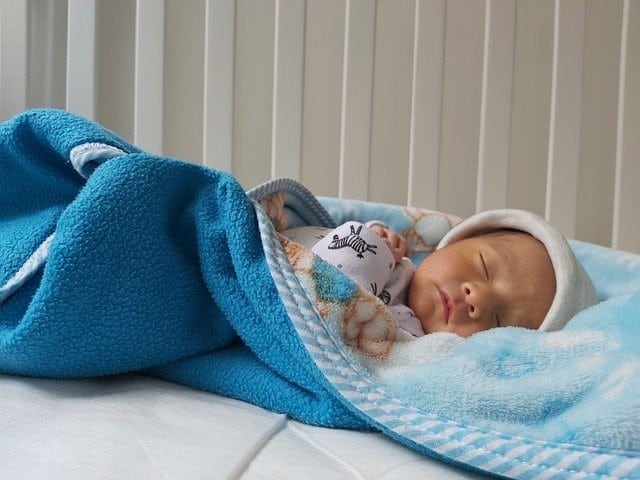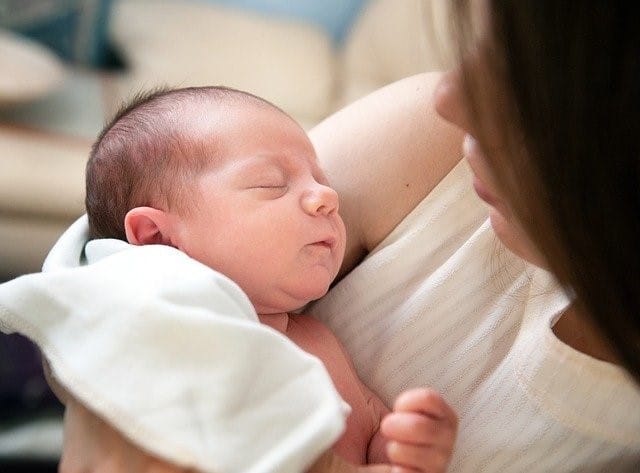Babies tend to sleep differently than the average adult human being. They require special care and assistance to ensure they, and everyone else in the household, can get quality sleep.
The creation of a baby sleep program and schedule requires careful preparation. Parents and guardians need to adhere to a routine to ensure their little one’s sleep program remains uninterrupted.
This article will explain the preparations needed to establish a healthy sleep schedule. The different baby sleeping schedules from birth to 36 months old will also be discussed, along with the recommended sleep training procedures.
Creating a Baby Sleep Program

Creating a baby sleep program for any baby starts with careful planning and preparation. This stage consists of the careful handling of the newborn and preparing the baby’s crib.
It is important to remove objects, such as blankets, pillows, and toys, from the crib prior to putting the baby down. Researches indicate that these objects may increase the risk of Sudden Infant Death Syndrome (SIDS), or the unexpected and unexplained death of a baby younger than one year old.
After ensuring a safe and cozy sleep spot, putting your baby carefully on his or her back is recommended by the experts. Placing an infant down on the crib in any other position will again increase the risk of SIDS.
It is also crucial to remember that parents and guardians should not fall asleep with their newborns beside them. Doing so will increase the likelihood of sleep-related deaths. An alternate option is to put your baby’s crib near your bed to significantly reduce the risk of SIDS.
Baby Sleep Schedule
A baby’s sleep requirements differ with age. Newborns require more sleep as opposed to toddlers, and their sleep patterns tend to be in short bursts.
As the baby continues to grow, their total hours of sleep decreases gradually. However, the length of time they sleep at night increases.
From Birth to 6 Weeks Old

Infants from birth up to 6 weeks old tend to have convoluted sleep patterns. In other words, their sleep schedule is relatively non-existent. Part of the reason for this erratic sleep cycle is because they need to be fed, on average, every 2 or 3 hours.
As such, a newborn baby tends to have 15-minute to 2-hour naps that take place four or five times throughout the day. At night, the longest stretch a newborn can sleep is 2 to 4 hours, for a total of 8 to 10 hours. This amounts to about 15 to 18 hours total of sleep on a 24-hour period.
The newborn stage may feel like a constant sleep-eat-poop cycle, which can be exhausting for parents. At this stage, the focus should be to ensure that little bundle of joy gets all the love, care, and sleep he or she needs, which is what matters the most.
6 to 12 Weeks Old

Babies between the ages of 6 to 12 weeks need about 14 to 16 hours of sleep per day. This sleep cycle includes a full 8 to 10 hours of sleep at night and four to five naps during the day.
Once the child hits 6 weeks old, parents and guardians may have already established a sleeping routine. At this point, the baby might also be becoming more social than before, so evening fussiness may already be developing.
As the weeks go by, the infant’s nap times become shorter. Hence, it might become tougher to stick to a regular eat-play-sleep routine. However, the child still needs to sleep about 14 hours per day.
3 to 6 Months Old

The body of a 3- to 6-month-old should start to become accustomed to the sleep schedule imposed by their parents and guardians. Daily routines might begin with an early morning feed, followed by some playtime, before the child falls asleep once more.
Parents and guardians need to be reminded, however, that their infant’s sleeping patterns might perform erratically. For example, if your baby sleeps well in the morning, the infant might not have the same sleep quality in the afternoon or at night.
Also, encourage the child to sleep in their own crib or cot. Feeding, playing, and sleeping routines work hand-in-hand for the baby to achieve a good quality of life.
6 to 9 Months Old

Babies in the 6- to 9-month-old range tend to sleep around 10 to 11 hours at night. Some infants around this age may get accustomed to the idea of sleeping without the need for a nighttime feeding.
There are still naps throughout the day, but they are now less frequent than before. Expect a 6- to 9-month-old infant to nap around two to three times during the day, and these daytime rests tend to last anywhere from 15 minutes to 2 hours.
9 to 12 Months Old

At 9 to 12 months of age, a baby may probably still be keeping his or her sleeping routine from the past quarter. Hence, parents and guardians should still expect their infants to sleep for about 10 to 11 hours per night and take two to three naps during the day.
Daytime naps might last up to 4 hours, depending on the child’s energy levels. Babies can have less sleep during the night if they have more hours of rest during the day.
12 to 18 Months Old

Once the baby reaches 12 months old, he or she may still need about two naps during the day. However, this daytime sleeping schedule may condense into one long nap instead of two short rests.
Parents and guardians need to look for the signs that their child is ready to make the transition from two short naps to one long sleep. The baby might take longer than before to show signs of being tired during the day as they resist the urge to take the nap. Otherwise, the child might start having shorter naps.
As for the baby’s nighttime sleep, it may remain the same as the two previous quarters. However, the frequency of waking up in the middle of the night, for feeding sessions, also decreases.
18 to 24 Months Old

At 18 months, a child may still be sleeping at around 10 to 12 hours per night. But the frequency of sleep interruptions due to hunger lessens further than the last quarter.
As babies continue to grow, they may still prefer to take one or two naps during the day. Parents and guardians need to take note of their child’s sleeping schedules, as daytime naps may affect a baby’s nighttime rest.
Sleep Training Methods
A common misconception about sleep training for children is that there is only one way to do it. Several techniques exist to help parents and guardians ensure that their little ones develop healthy sleep habits. Below are three of the most common sleep training methods and how they work.
The “Fade it Out” Method (FIO)

This popular sleep coaching method aims to sleep-train babies with no tears or with very little crying involved. The idea is to gradually fade out whatever method (rocking, nursing, singing) parents use to put their baby to sleep until it is no longer necessary.
For example, if your routine involves rocking the baby to sleep, you may slowly shorten the amount of time you spend rocking for a few minutes each time, until the baby is weaned off from rocking.
Using this sleep training technique may require a bit of patience as the results may take longer to surface. But with this method, babies are allowed to figure out how to soothe themselves, and sleep on their own, minus the trauma.
It is a good idea to start the FIO technique from 6 weeks old. However, a mobile and fussy baby might be quite difficult to put to sleep using this technique.
The “Cry it Out” Method (CIO)

As its name implies, the CIO is a sleep training technique that involves putting babies to bed and not helping out even if they start to cry. Parents using this method are not supposed to help their babies, and let them cry or fuss, until they fall asleep on their own.
The idea behind the CIO technique is to help babies discover how to sleep without relying on their parents for assistance. Also known as “the extinction method,” this technique will likely involve a lot of crying, which can be hard for some parents.
The Pick-Up and Put-Down Method (PUPD)

PUPD is another gentle method of sleep training. With this technique, during sleep time and the baby cries, a parent comes to pick up the baby and give comfort until the baby stops crying and becomes drowsy again. At this point, the baby is placed back in his or her crib, and the cycle is repeated until the baby finally falls asleep.
This method may work for younger babies. But as the baby gets heavier, it becomes increasingly difficult. PUPD may also tend to stimulate other babies and make them more upset. Parents may need to repeat this method many times before it is successful.
PUPD requires patience and consistency. It is important to remain calm as parents soothe their baby each time they cry. Parents who choose this method can soon enjoy their babies sleeping on their own without relying on their parents as some sort of prop. Plus, the baby does not feel abandoned during the process.
Final Thoughts About Baby Sleep Program

Getting a baby to follow a sleep program may not be easy, but developing healthy sleep habits is an essential life skill. One cannot argue about the benefits of a good night’s sleep – both for babies and exhausted parents.
If you are on the fence about baby sleep programs, it is worth noting that there is no right or wrong method and that each child may respond differently with each approach. Remember that sleep patterns tend to change as the baby grows. Pick the program and method that you think will be best for your baby and that you can be comfortable with. Be patient. Before long, your baby will grow and embrace his or her independence, and you will be glad you took the time to appreciate the little things along the way.